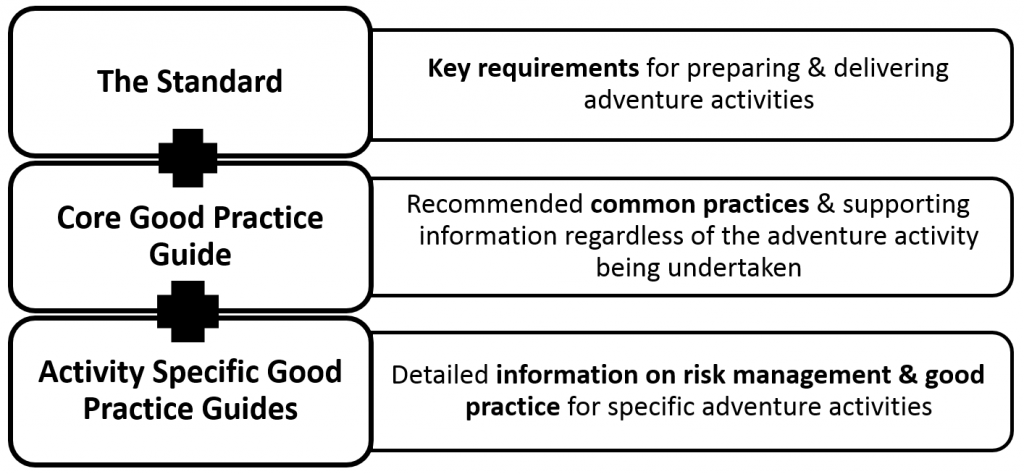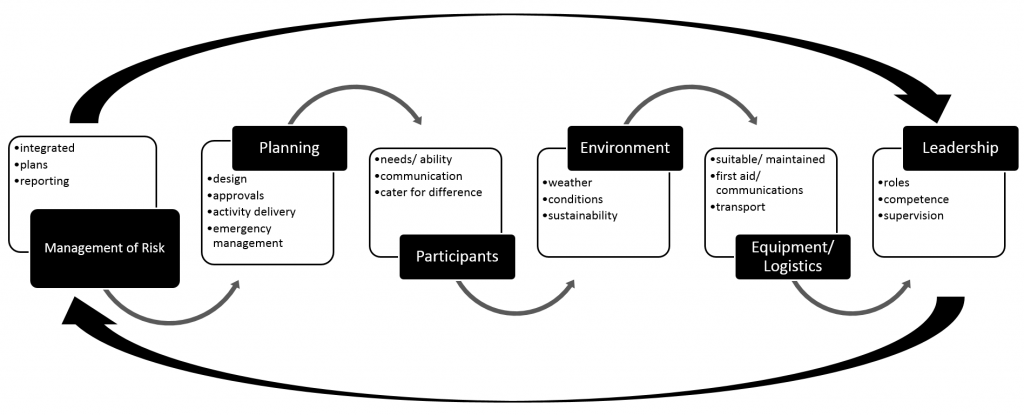Australian Adventure Activity Standard (AAAS)
Key requirements for preparing and delivering adventure activities.
Version 1.0 | Date 23 Sept 2019 | Details: Version one release.
Acknowledgment, disclaimer and preface
1 Introduction
1.1 Introduction to the adventure activity standard
The Australian Adventure Activity Standard (AAAS) and associated Good Practice Guides (GPG’s) provides essential information relating to the safe and responsible planning and delivery of adventure activities with dependent participants. The documents are designed as a voluntary good-practice framework for adventure activity providers and include guidance on matters of safety, compliance and service delivery as well as environmental and cultural protections.
Within the AAAS and GPG’s, a provider refers to any organisation, business, community group, government agency, school or others who organise and lead adventure activities with dependent participants.
Dependent participants are those who are reliant on the activity leaders to support their participation in an adventure activity. The degree of dependence of participants may vary based on, for example, the participants age, maturity, competence or skill; and/or the challenges and circumstances of the activity and/or the environment. Each provider needs to determine if they are working with dependent participants.
The guidance for adventure activities is comprised of several documents:

The adventure activity documents are developed to present cumulatively more specific information. Providers, managers or those responsible and accountable for the design, planning and delivery of adventure activities should determine how they use the AAAS and GPG’s based on an understanding of appropriate practices, individual circumstances, and need. Where applicable, it is recommended that providers periodically check the AAAS, and GPG’s and draw on these in the development and review of their Standard Operating Procedures (SOP’s).
Activity providers are encouraged to obtain independent professional and legal advice in relation to their obligations and duties in delivering adventure activities and should reference the relevant laws to the area in which they intend to undertake the adventure activity.
1.2 Guidance for using the Australian Adventure Activity Standard
This Standard and the Good Practice Guides identify essential considerations that help providers apply a systematic approach to the management, planning and delivery of adventure activities. They do this through a structured framework that outlines the importance of:
- Developing contextually relevant risk management processes and procedures
- Undertaking planning to design, prepare and support adventure activity delivery
- Identifying and understanding the abilities and needs of participants and the importance of timely communications
- Ensuring that equipment and environments are appropriate and fit for purpose, and
- Selecting leaders with appropriate skills and experience to lead the activity.

While the components of the AAAS framework are discussed separately in the documents, they are all inter-related. Providers are encouraged to consider how they address each component of the framework, and how these work together in their own adventure activity management system/s.
2 Management of risk
2.1 Risk management
Risk is defined as the ‘effect of uncertainty on objectives’ and can result in positive and negative outcomes. The management of risk involves systematically:
- identifying the range of factors and influences that might impact on achieving objectives, and
- putting in place coordinated activities to direct and/or control these factors (adapted from AS/NZS ISO 31000: 2018 Risk Management Guidelines).
The management of risk and the development of safety systems must focus on all stages of the design, planning, preparation and delivery of adventure activities.
Risk management systems must be flexible, adaptive and responsive.
While the AAAS identify a range of potential risks, these may not be fully comprehensive. The management of risk may include addressing aspects not identified in the Standard. These could include, but not be limited to such things as additional site-specific hazards.
2.2 Risk management requirements
Risk management is a commitment and process that must be integrated into all aspects of the providers’ governance, management and operations. This ensures risk management is embedded into the policies and practices of the provider and covers all the factors that contribute to risk, not just those occurring during the delivery of the adventure activity itself.
A risk management plan identifies hazards and assesses risks for an activity and specifies how these will be managed. Risk management plans must be documented for each activity.
The development and implementation of risk management involves several steps. These include:
- Specifying the context of the adventure activity/s
- Identifying people, equipment and environmental hazards
- Assessing who or what might be harmed, how and to what extent
- Determining the level of risk considered acceptable to the participants or client organisation and the activity provider
- Analysing the risks and selecting appropriate risk controls. This informs decisions on what risk management controls are required for the context and objectives
- Implementing the controls
- Having a communication structure to inform people of their relevant responsibilities
- Actively monitoring risks and the effectiveness of controls
- Modifying risk controls as and when necessary.
Effective risk management also includes ensuring compliance with all relevant laws and/or regulations that apply to the activity and the context. It should be noted these may change over time.
2.3 Incident reporting
There must be a process for reporting incidents and near misses. Some incidents will also need to be reported to relevant government authorities (e.g. Police, local Work Health and Safety, Insurers, Land/Water managers).
Information on incidents and near misses should be collected and assessed.
Providers should also periodically review other incidents related to adventure activities they conduct. Incident and near miss information should be used to develop risk management strategies and to inform risk treatment, program design and delivery.
3 Planning
3.1 Planning
Whether preparing for one, or a series of activities, the management, design and delivery of adventure activities requires good planning. Planning allows providers to:
- meet their own objectives (e.g. to comply with laws, provide enjoyable/ educative experiences, sustain financial viability); and
- contribute to the objectives of their members, clients or partners (e.g. achieve personal goals, social interaction, leadership/ skill development).
There must be a process in place for the development and approval of activity plans that suit the context and purpose.
3.2 Activity plans
Activity plans help bring to life the purpose and objectives of the activity. They also inform decisions made before, during and after the activity.
Inclusions in the activity plan will vary but should include:
- Purpose: What is the purpose of the activity?
- Participants: Who are the participants and why is this activity relevant?
- Location/s: Are the location and conditions suitable for the activity?
- Risk: What are the risks involved and how will these be managed?
- Emergency Management: How to respond in case of an emergency?
- Logistics: What needs to be organised (e.g. permission, transport, equipment)?
- Leaders: Who will lead the activity and what competencies and currency do they need?
- Contingency: How to respond if things change?
3.3 Cultural, historical and environmental values
Consideration and respect for the cultural, spiritual and historical significance of sites, places and people should be factored into adventure providers’ planning and delivery of services. Considerations may include:
- recognising and giving due regard to the feelings, wishes or rights of others
- seeking information and/or permission from native title holders, Traditional Owners and/or other land managers
- respecting and applying appropriate cultural values
- implementing environmental sustainability practices.
3.4 Emergency management planning
Actionable plans must be developed to support timely and effective response in case of an emergency.
Emergency management plans must be:
- specific and include documented emergency processes and procedures
- familiar to those who need to implement them
- shared with other appropriate people or agencies (e.g. land managers, a responsible non-participating person and/or participants)
- periodically reviewed, practiced and updated.
3.5 Activity leader documentation
Activity leaders must have timely access to relevant documentation to assist them prepare for, and deliver, the activity.
4 Participants
4.1 Participants
The needs and abilities of participants must be considered at every stage of adventure activity design, management, planning and delivery.
Considerations relating to participants should include:
- taking reasonable steps to understand the abilities and needs of individual participants, group and/or client organisation
- using understanding of participants to design, plan and deliver an appropriate program
- effectively communicating timely information about the activity or program and its requirements
- implementing a process to obtain relevant details on pre-existing health or personal conditions, informed consent and acceptance of risk to participate before the activity begins
- meeting any legislative or legal compliance expectations relating to participant health and safety. Some examples: vulnerable person and child safety protection laws and regulations, privacy laws, anti-smoking/ drug laws, sex discrimination laws and regulations, allergy and anaphylaxis safety for minors’ laws etc.
5 Environment
5.1 Environment
Providers have a responsibility to understand the environments in which they are operating. Further, they have a responsibility to implement practices that address principles of environmental sustainability.
To maximise safety, relevant environmental conditions and impacts must be considered in risk management and activity plans.
These conditions include:
- weather and emerging weather variations
- geography
- seasons
- sun safety
- local flora and/or fauna hazards or impacts
- severe weather and fire weather warnings
- bushfire and fire danger rating.
Providers should identify and monitor weather and environmental conditions that might trigger modification, evacuation or other relevant response.
6 Equipment and logistics
6.1 Equipment requirements
The equipment selected must be suitable for the purpose it will be used.
This includes ensuring all equipment:
- meets any legislative or regulatory requirements
- is appropriately serviced, stored and maintained
- is appropriate in style, size, quality and quantity for the activity and client.
Communications, first aid and emergency response / rescue equipment must be:
- suitable for the context and the activity
- accessible, adequate and appropriate for the potential hazards and risks involved.
6.2 Logistics
At times it may be necessary to transport dependent participants for the activity.
Vehicles and drivers must comply with any transport laws and/or regulations.
7 Leadership
7.1 Leadership
Adventure activities must be led by competent people who have appropriate skills, knowledge and experience.
Providers must ensure activity leaders involved in activity delivery:
- conform with the providers’ risk management systems
- have current, verified and documented skills, knowledge, experience
- only assume roles within their skills, knowledge, experience
- provide an appropriate level of supervision for the activity context
- are fit to fulfil their duties (e.g. managed for health, fatigue, medications)
- comply with appropriate activity-specific recommendations of activity leader to participant ratios.
8 Conduct of activities
8.1 Conduct of activities
This Standard provides requirements and recommendations relating to the safe and responsible delivery of adventure activities with dependent participants. Further information, description and detail can be found in the Core Good Practice Guide and Activity Specific Good Practice Guides. It is recommended that providers refer to these for additional support.
Glossary
Refer to the Core Good Practice Guide – Glossary.
